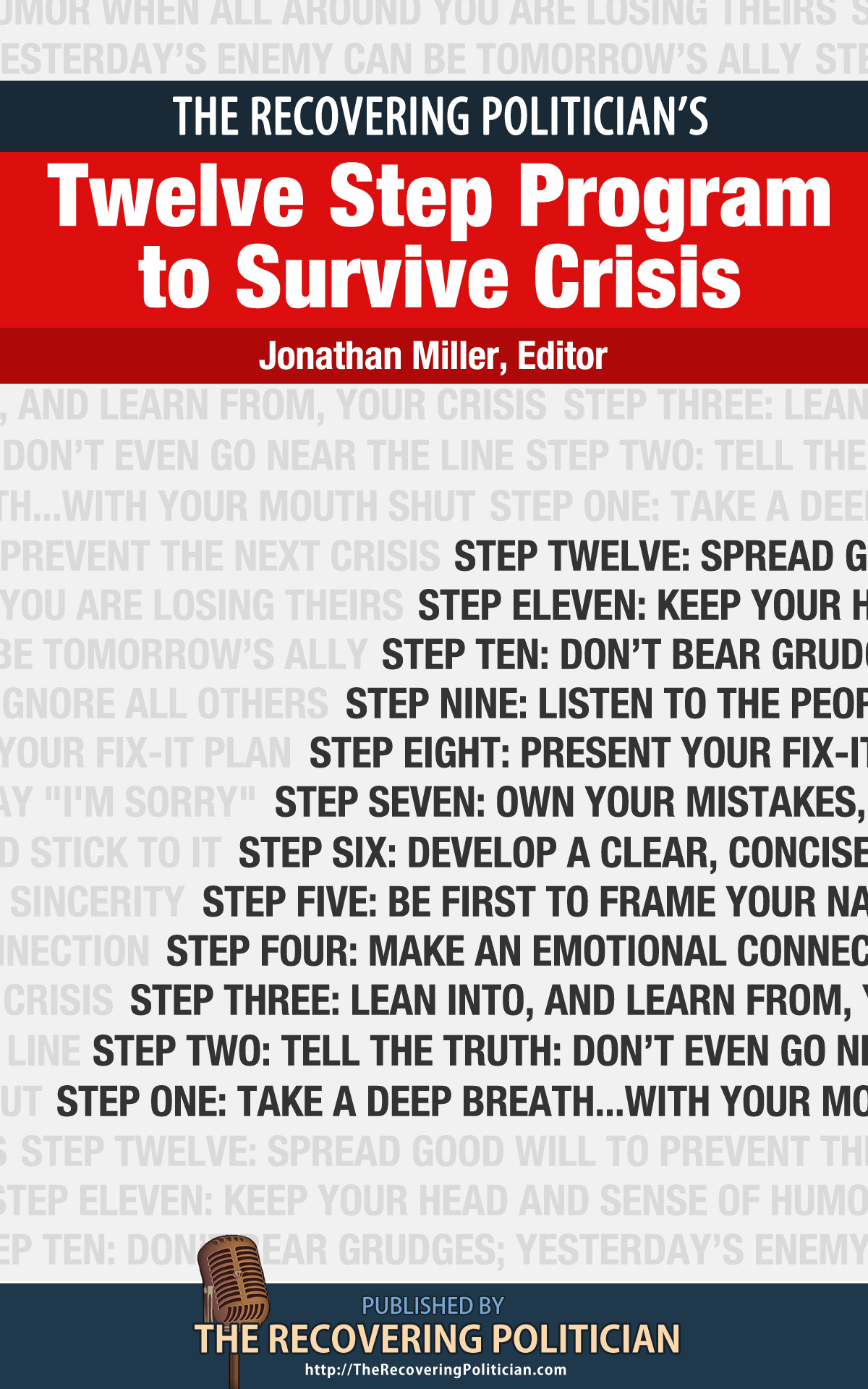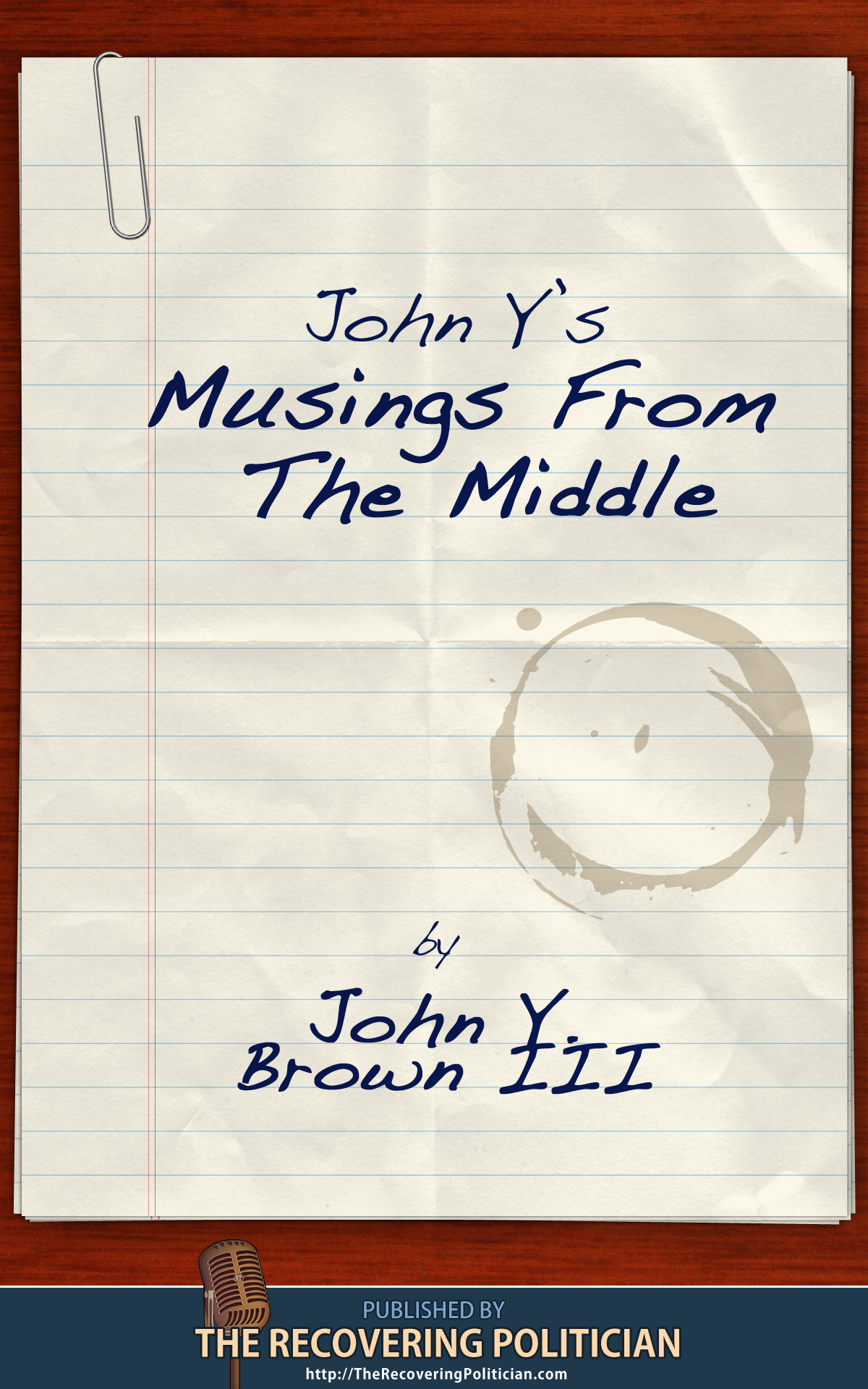By John Y. Brown III, on Thu Dec 5, 2013 at 12:00 PM ET It’s hard to know the course we are on or where we are in the race or even where it will take us.
Sometimes it isn’t clear if we are closing in on the finish line or the edge of a cliff.
And sometimes when it seems to be the edge of a cliff it is really only a small jump down and part of a longer obstacle course.
 And sometimes when it seems to be the finish line and we push out our chest to secure victory we learn we have already been lapped by our competitor. Or forgot to hand off the baton several laps ago. And sometimes when it seems to be the finish line and we push out our chest to secure victory we learn we have already been lapped by our competitor. Or forgot to hand off the baton several laps ago.
Which means, I guess, not to waste too much time anticipating or prejudging and do your best to adjust and make the most of whatever you find around the next turn.
And if you have been carrying a baton for several hours, you probably have some explaining to do.
By Josh Bowen, on Thu Dec 5, 2013 at 8:30 AM ET
The greatest minds in the human races’ history have always asked one question, Why? Einstein, Edison, Newton all posed the question of why and no matter how many times they failed they constantly pushed forward. The Power of Why.
Think about a child who is inquisitive, what do they ask repeatedly? Why? Why is the ocean blue? Why do I have to go to sleep at 8? Why do I have to go to school? Why why why? Their nature is to constantly pose the question of why so they can consistently
The why gives reason behind decisions and clarity behind things that are not yet understood. Reason and clarity are very big when discussing fitness goals: Why is getting in shape important to you? Why will having bigger arms or a smaller waist positively impact your self esteem? Why?
As you embark into a fitness regime it is important to remember why you are starting. From the mere example of you reading this means, on some level, you are interested in fitness. Either you; are wanting to start, wanting to continue what you started or are looking for fresh ideas to keep you going. Either way, we all go through a pre-contemplation phase when it comes to working out. Some decide to put both feet in and go after it others keep one foot in and the other out and then there are those that never start. The decision is a personal one but once we cross into the stage of doing something about our current situation, it is important to remember why we are doing it.
So here is what we are going to do…
I am going to generalize everyone and pose the following questions:
1. What outcomes are you wanting/expecting from exercise program?
2. Which of those outcomes is the most important to you?
3. Why is that so important to you?
 The answers to any of those questions can and will vary considerably. Everyone starts or continues and fitness program for different reasons. The importance to find the why behind the what. Is the answer to number one; more energy, less body fat or to be healthier? We can easily put those answers into three categories; how you feel, how you look and how your insides are functioning. Either way these are important to you.
Now we must pick one as our sole goal to focus on. This should be the driving force on your fitness journey, the thing you cannot live without. Once we have answered that we are on our way.
Lastly, we must instill the Power of the Why. Why is that goal important to you and why is it the most important to you? The answer will define your fitness experience and adherence. Is it because you’ve always wanted abs or because you felt better when you were 20 lbs lighter? At the end of the day we all do this for an emotional reason and to boost how we feel about us. Nothing more, nothing less. Fitness changes us for the better by supplying confidence and increased self esteem we may not have gotten from anywhere else. This is the Power of the Why!
Never forget your why and the reason you do this. On the days when you don’t feel well or you’re stressed from work. Remember your why. It is powerful beyond all comprehension.
PS: Write your most important goal down and the reason it’s so important on your mirror or car dash. When times get rough and you feel like quitting look at it and remember why you are here. Positive thoughts and energy creates positive outcomes.
By John Y. Brown III, on Wed Dec 4, 2013 at 12:00 PM ET A defining moment……that any of us can have. Frequently.
People may not always remember a kind act…. but almost never forget being treated rudely.
And although a kind act my lead others to think well of us for a brief time ….if we treat someone poorly they tend to define our nature as rude and our intentions as suspect.
 A person who is viewed by another as rude and suspect can almost never be viewed by that same person as genuinely kind or completely trustworthy. A person who is viewed by another as rude and suspect can almost never be viewed by that same person as genuinely kind or completely trustworthy.
So when you are about to treat someone rudely, make sure you chose thoughtfully, carefully and wisely. Because you are not simply about to exhibit a flourish of rude behavior; but rather are about to define yourself with someone for a very long time
By Lauren Mayer, on Wed Dec 4, 2013 at 8:30 AM ET Okay, maybe the older version of that title phrase (involving contempt) might still be true regarding annoying relatives. (My father used to insist there was just one small group of them who went from wedding to bar mitzvah to reunion, changing accents and clothing but otherwise identical, and including the great-aunts who commiserated about their digestive issues, the cousin who told offensive jokes, and the cocktail-swilling uncle who insisted on singing his off-key version of “New York New York” with the band. But I digress.)
However, I have noticed that when people get to know someone with a different political viewpoint, sexual orientation, or national origin, they are much more likely to view them positively. This has been strikingly true when it comes to issues like same-sex marriage, where even die-hard conservatives with gay relatives soften their views (unless they have another relative running for office on an anti-gay-marriage platform . . . . see Cheney: Dick). I know I’ve become more tolerant of conservative views with which I disagree since I found out a few of my best friends are Republicans and I took the time to listen to their reasoning. (I still disagree with them, but at least I don’t think of them as mutant aliens – remember, I live in the San Francisco area, where Republicans are as rare as Democrats were when I was growing up in Orange County.)
Speaking of growing up in Orange County, back in my day, Jews were equally rare, so I was usually the only kid in my class who could explain our holidays. I actually did have to correct one 4th grade classmate who had heard that Chanukah involved worshipping potato chips. (He’d heard something about potatoes and frying . . . love that 4th grade logic!) (Mind you, Jews can be equally ignorant, especially given the rampant commercialization of Christian holidays – when they were little, my sons were convinced that Christmas celebrated the birthday of Santa Claus.)
So in honor of Chanukah, I thought I’d offer a few pointers to help those of you who don’t celebrate it.
– Chanukah started several thousand years ago, so it isn’t part of an insidious war on Christmas
– Chanukah is a relatively minor holiday (we have TONS of them), so faux-Christmas touches like Chanukah bushes are not very authentic
– Latkes (potato pancakes) and sufignot (jelly donuts) are traditional and delicious, meaning the holiday is a great excuse to eat fried food
– Contrary to what some envious kids might think, Jewish kids don’t usually get 8 days of elaborate gifts (as a rule mine get one big present and 7 days of wrapped-up books, snacks, and socks . . . hey, I’m a working musician and this is my busy period!)
And in case you need any more clarification, here’s a little musical explanation –
“The Chanukah Cha Cha”:
By John Y. Brown III, on Tue Dec 3, 2013 at 12:00 PM ET Travel advice.
If you run a business off your laptop, be sure not to leave the laptop in the seat pocket in front of you after idling on the Tarmac for 45 minutes before take-off.
It is posaible you will get in a conversation with a man from Jordan in the window seat next to you and forget to use the laptop when airborne and above 10,000 feet. (As a sidenote airplanes these days go much higher than 10,000 feet. In fact, about 35,000 —Vanessa Armstrong and Steven Riggs. Not everybody knows this but probably should. Especially of they are going to post about air travel on Facebook.)
Back to the main topic. If you do get engrossed in a conversation with a member of the Jordanian military under these circumstances DO NOT leave your laptop in the seat pocket in front of you. Also, if asked by the Jordanian member of the military seated next to you “What do you know about Jordan?” Don’t say “You mean Michael Jordan? The greatest basketball player of all time?” Because that is not what they are talking about. They are talking about a different Jordan that you probably don’t know much about. (Hint: Try Googling Jordan, the country, when they are not looking so don’t sound like a complete embecile).
 And if you do leave your laptop in the seat pocket and it is a US Air flight, call customer service and ask for Roberta. She is great and can help you locate your laptop the next morning. Just don’t try to blame USAir for your memory lapse. That only ticks off Roberta and she won’t try as hard to find it for you. And if you do leave your laptop in the seat pocket and it is a US Air flight, call customer service and ask for Roberta. She is great and can help you locate your laptop the next morning. Just don’t try to blame USAir for your memory lapse. That only ticks off Roberta and she won’t try as hard to find it for you.
Hope this helps.
Also, turns out Jordan is a really interesting place to talk about. But probably not worth losing your laptop over.
===
What I did over the last two hours.
On plane to NYC
Left Louisville, Kentucky this late this afternoon to travel to New York City, New York.
Not walking, of course.
Not taking horse drawn carriage.
Not traveling by boat.
Not traveling by automobile either.
But flying –soaring really–12,000 feet above the ground at over 500 miles per hour.
Over 500 mph!!
Like a giant steel bird flying confidently and safely through outer space high above the clouds and now swooping down to land in a new brightly lit up city with millions and millions of strangers just like you and me but different too.
Kaboom!!
Wheels touched down and we have arrived in New York City, New York from Louisville, Kentucky in a 2 long hours.
We are not your tired and huddled masses seeking refuge but more like well rested and well fed aliens visiting from a distant planet because we can.
For the weekend.
I suspect that Lady Liberty in her permanently proud and protective pose is trying to defy gravity by grinning to herself and thinking “This is happening!”
By Erica and Matt Chua, on Tue Dec 3, 2013 at 8:30 AM ET After spending nearly three years on the road, we look back on all that we put up with to save a dollar. Were all the long bus rides and sleeping at airports worth it to keep the expenses in check?
HE SAID…
You’ll never hear me claim that there is a better way to travel than budget travel. Getting as close to the locals’ spending as possible is the best way to understand how their life is…and isn’t that why to travel? Not only the experiences, but also the differences between experiences in different places are enlightening. Exposing yourself to where the locals eat, stay and play will teach you more about a place than a tour ever would.
If I wanted something easy and comfortable I’d try to have that at home, not in some distant land. Why would I put my money towards temporary comfort instead of investing in permanent comfort? At home I want the most comfortable things possible, but on the road I want the most locally authentic experiences possible.
This does create some problems though. It’s caused us to end up in some places where I was deathly allergic to things. It’s led us to some pretty dirty places. It’s made us terribly sick. The romantic idea of living like a local is much better than it is in reality.

Here is one great example. We thought we had scored a great deal on a place to stay in Seoul, in a student building, on AirBnB. The listing made it clear that it could sleep two, evenings were quiet times, and there was free rice. They had me at the price, but I fell in love with the idea of free rice. See the photo above? That’s how we slept for three nights. On the fourth day I ran into the building manager, the same person who had checked us in, and he asked how we were sleeping. I responded that we were doing fine. Then he asked the key question, “would you like another mattress?” Why yes we would! How had he failed to mention this earlier, such as when the two of us checked in?
Read the rest of…
Erica & Matt Chua: Budget Travel Gripes
By John Y. Brown III, on Mon Dec 2, 2013 at 12:00 PM ET Horn honking rules of etiquette:
When waiting at a traffic light that has turned green but the car in front of you hasn’t noticed yet.
1) One short honk means a head’s up to driver that the light has changed
2) Two short honks means the light has changed and the driver honking is in a hurry
3) Three short honks means the light has changed, the honking driver is in a hurry and thinks the driver …in the car in front of him is an idiot.
 4) One long honk means the honking driver is a total a****le and is in a hurry because he started late and is an idiot. ( 4) One long honk means the honking driver is a total a****le and is in a hurry because he started late and is an idiot. (
Note: if the honked at driver responds with a symbolic retaliatory hand gesture, then he becomes a bigger a***ole and idiot than the honking driver.)
By Jonathan Miller, on Mon Dec 2, 2013 at 10:00 AM ET The Recovering Politician is proud to present the latest project by Friend of RP Mark Nickolas, recovering political blogger and now award-winning documentary filmmaker:
THIS IS NOT GRAFFITI: A Film on Revolutionary Graffiti & Art — a short film exploring use of political graffiti and street art as a catalyst for popular revolutions and uprisings around the world.
Please join me as a backer of Mark’s exciting new project at Kickstarter!
This Is Not Graffiti is a 20-minute short documentary film on the critical role that politically-charged graffiti and street art has played in uprisings and revolutions around the world, particularly the recent popular revolts in the Arab world that began in Tunisia in 2011.
Despite the preferred media narrative that the Arab uprisings were the ‘Facebook Revolution,’ what is often overlooked is the enormous impact that anonymous graffiti and street art played in galvanizing the public (particularly youth) and served as a revolutionary call-to-arms, where the walls became a canvas to speak truth-to-power and proved to be a powerful weapon of resistance.
In fact, the current conflict in Syria began simply with a group of teenage boys who, while watching the events in Libya and Egypt unfold on TV, spray-painted on their school wall the simple phrase “Your Turn Has Come, Doctor” — referring to President Assad, a Western-trained ophthalmologist.
Throughout the Middle East and North Africa, graffiti and street art became the prime communications vehicle for people to vent their anger, express their hopes and dreams, and demand action.
But this phenomenon is hardly new.
Graffiti dates back to walls of prehistoric caves. But its modern use as a political weapon came into plain view in revolutionary pre-war Europe of the mid-1900s, eventually coming into its own during the 1968 French riots where all across Paris, a groundswell of creative street expression came from striking workers and students, who spray-painted walls with poetic and philosophical slogans, speaking to its readers on a much more emotional level.
Since then, revolutionary graffiti and street art can be found all over the world and has played a vital role during times of political transformation and social instability, creating a shared public visual space which symbolically and physically challenges the establishment and the dominant ideologies, and has tremendously influenced the great social and political upheavals of the past century.
THE FILM
This Is Not Graffiti will examine this history and evolution while telling this global story by way of a local one, mixing interviews on the subject here in the New York City area with a week in Cairo talking with those who have made, studied, and been directly impacted by these words and images.
The film will also explore how this effort to demand change from governments has led to other calls, most prominently from women in Egypt — a country that recently ranked last in the Middle East for women’s rights — who have taken to street art to demand change from their own society.
A revolution within a revolution.
Please join me as a backer of Mark’s exciting new project at Kickstarter!
THE PLAN
We are seeking the funds in this Kickstarter campaign to fully produce, finish, and submit the film to festivals around the world by the end of Spring 2014. You join us on the ground floor for this endeavor.
We have been in touch with several of the people who we hope to visit with and interview on-camera, and are ready to begin production as soon as this campaign is successfully funded.
We will interview people in the New York City area in early January 2014, and then fly to Cairo in February during the third anniversary of the Egyptian revolution where we will spend a week shooting.
Editing, scoring, and finishing the film will be completed by April when we will begin an aggressive film festival campaign—domestically and internationally—where we fully expect the film will find a home for the next year or two.
THE FUNDS
Filmmaking is not an inexpensive endeavor and funds for independent documentaries are in short supply. Your donations will allow us to fully fund this film (***there will be no second Kickstarter project to finish this film, we promise!***), permitting us to:
• rent film gear: while we own much of the equipment needed, we will need to rent some lighting accessories, camera gear, and some additional audio components.
• transportation: a week in Cairo, Egypt for our very small crew will account for the vast majority of our travel costs, though there will be several days of production travel locally, as well.
• music: allow us to hire a composer for an original score for the film.
• crew: our very small crew of three will require very modest funds to pay for a cinematographer and sound recordist, and a small fee to direct and produce this project.
• post-production work: while we will handle a large majority of the work for this film ourselves, we will need to outsource some graphic design, audio work, color correction, and film transfers to specialty houses.
• film festival submissions: film festival submissions, even for shorts, run between $35 and $50 a piece, and an aggressive festival campaign will require 75-100 submissions, and the cost for us to attend our theatrical premiere.
• miscellaneous production expenses: production always requires small purchases that add up — from food for the crew and volunteers, to periodic runs to Office Deport or Radio Shack or Home Depot, to unexpected fees for traveling and driving, etc.
• Kickstarter rewards: though we were careful to create great rewards for our donors, we were also cost-conscious in making sure that they accounted for a reasonable portion of the overall budget to create, acquire and ship.
Please join me as a backer of Mark’s exciting new project at Kickstarter!
By Saul Kaplan, on Mon Dec 2, 2013 at 8:30 AM ET One of my biggest pet peeves is setting strategy one tactic at a time. It drives me crazy to be surrounded by people and organizations that think if they just work hard enough and do more things that a strategic direction and destination will emerge. It seems that most of the world works this way. It is terribly inefficient. How many people and organizations do you know that pedal the bicycle like crazy but never seem to arrive anywhere. They just keep pedaling harder hoping that something will eventually stick. It is exhausting watching them. Why not determine a destination and work hard on those things that help you get there. It seems so simple. Setting a strategic direction provides a way to know which tactics are aligned and contribute to reaching the destination. The destination may change along the way requiring different tactics, and that is OK, but not having a destination at all is a ticket to nowhere.
When John F. Kennedy said, “We choose to go to the moon” in 1961, Americans rallied around the destination. We believed it was possible and the goal of setting foot on the moon rallied a country to advance its global science and technology leadership. It was cool to study math and science and clear that innovation was the economic engine that would drive American prosperity. When Neil Armstrong set foot on the moon eight years later and said, “That’s one small step for [a] man, one giant leap for mankind”, we celebrated his achievement as if it was our own and knew at that moment that anything was possible. We have been trying to get that feeling back ever since. Today, we have no clear destination, in space or on earth.
 I am still trying to process President Obama’s plan to cancel NASA’s Constellation program for manned space flight back to the moon. OK, I thought, maybe he has a bolder more imaginative space destination in mind or a better way to get back to the moon. It turns out that the announced strategy identifies no new destination at all and has been called a “flexible path” focusing on enabling technologies. The destination will be determined later. Please say it isn’t so. It is impossible to be inspired with out a destination and it is terribly inefficient to develop enabling technologies with out an end in mind. I am still trying to process President Obama’s plan to cancel NASA’s Constellation program for manned space flight back to the moon. OK, I thought, maybe he has a bolder more imaginative space destination in mind or a better way to get back to the moon. It turns out that the announced strategy identifies no new destination at all and has been called a “flexible path” focusing on enabling technologies. The destination will be determined later. Please say it isn’t so. It is impossible to be inspired with out a destination and it is terribly inefficient to develop enabling technologies with out an end in mind.
My second thought upon hearing the new NASA strategy was that maybe President Obama wants to turn our attention and resources toward earth and create an inspiring space mission like focus on fixing health care, education, or climate change. We have no clear destination for any of these huge system challenges. We continue to play around the margins hoping that incremental changes will launch us toward systemic solutions. It isn’t working. We need to transform each of these systems and it will take “moon landing” like clarity and commitment to make it happen. So maybe the president plans to shift attention and resources away from space exploration toward transformation here on earth. No such luck.
It isn’t as if the NASA budget was cut freeing up resources for other priorities. The proposed budget actually increases NASA’s budget by 2% allocating $6B over 5 years to create a commercial taxi to the space station. The budget comes nowhere close to the $3B a year that the recent expert advisory panel suggested was needed to create a robust manned space program. So we appear to be lost in space and on earth. We will continue to invest in space technologies without a clear destination and we will continue to work around the margins of the important system challenges we face here on earth.
It is enough to make you scream. All I can think of is Ralph Kramden in the Honeymooners getting angry and red in the face, proclaiming, “To the moon, Alice”!
|
The Recovering Politician Bookstore
|
 And sometimes when it seems to be the finish line and we push out our chest to secure victory we learn we have already been lapped by our competitor. Or forgot to hand off the baton several laps ago.
And sometimes when it seems to be the finish line and we push out our chest to secure victory we learn we have already been lapped by our competitor. Or forgot to hand off the baton several laps ago.










